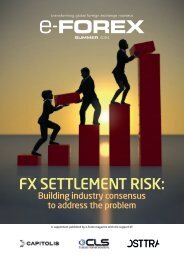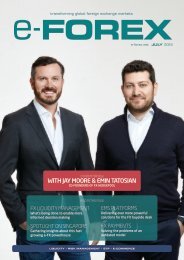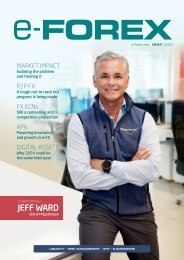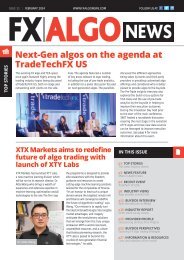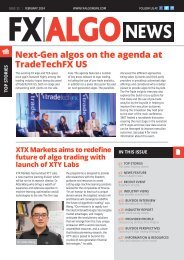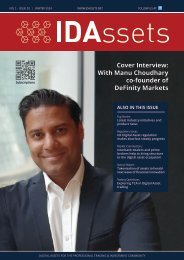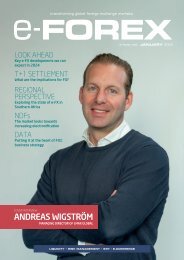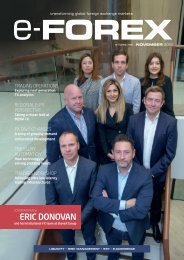Create successful ePaper yourself
Turn your PDF publications into a flip-book with our unique Google optimized e-Paper software.
TRADING OPERATIONS<br />
robust, standardised data and highperformance<br />
infrastructure, there<br />
is a huge opportunity in this area.”<br />
He cites an example. “One area that<br />
is getting a lot of focus currently is<br />
AI-driven alerting, informing users<br />
about things happening in their<br />
trading business that they might<br />
not otherwise be aware of. With<br />
the huge amount of data available<br />
individuals cannot check all potential<br />
factors that might impact their<br />
business. AI will play an essential role<br />
in pointing them to the issues that<br />
need attention.”<br />
BidFX’s McGrath talks about a few<br />
initiatives. “We already have a team<br />
working on this developing product at<br />
BidFX and although the industry is still<br />
in the early phase of rolling out these<br />
features there could be some real<br />
efficiency and quantifiable benefits for<br />
the sellside and buyside in how MIS,<br />
data, and analytics are accessed and<br />
actioned upon,” he says.<br />
ION’s Liew adds, “The role of the<br />
Liquidity Manager can be automated<br />
to a certain extent by AI, such as<br />
finding optimum combinations of<br />
Market Takers, Liquidity Providers, and<br />
Currency Pairs quickly. This can be a<br />
tedious manual process.”<br />
COLLABORATION AND THE<br />
EVOLUTION OF FX ANALYTICS<br />
While solutions providers are offering<br />
innovative solutions, they’re hampered<br />
by the sheer number of touchpoints<br />
in the execution workflow. Reactive<br />
Markets’ Morris lays out the issue.<br />
“Market participants often have<br />
many market-facing execution touch<br />
points within a given workflow,” he<br />
says, “whether an execution protocol<br />
(ESP, RFQ or Algo,) or platform being<br />
used. Consolidating that into a single,<br />
normalised view of the world can be<br />
complex, with specific benchmarks<br />
and analytical requirements by each<br />
individual counterparty.”<br />
“It’s difficult to put a monetary cost on rejected orders as<br />
there is no guarantee that another LP would have filled<br />
them, especially in a volatile environment,”<br />
Collaboration and integration<br />
between platforms is the best way to<br />
solve this roadblock, Morris says. “By<br />
collaborating and having connectivity<br />
to the leading analytics and TCA<br />
providers in the market, clients have<br />
the flexibility and opportunity to<br />
automate much of their data and<br />
algo analytics while we complement<br />
the workflow by providing leading<br />
execution performance and<br />
connectivity to liquidity providers. This<br />
superset of independent data from<br />
a variety of sources allows clients to<br />
make informed, data-driven decisions,<br />
something which we encourage and<br />
actively facilitate in providing our<br />
clients access to.”<br />
Hopkins adds to this view. “Without<br />
collaboration through data, firms are<br />
solely restricted to their own view of<br />
the world,” he says. “FairXchange<br />
was conceived purely to facilitate<br />
collaborative dialogue between<br />
trading counterparties. It is even the<br />
inspiration of our name – the fair<br />
exchange of data between trading<br />
firms to arrive at the optimal mutual<br />
outcome.”<br />
Lambert thinks our daily conditioning<br />
to data readily available on<br />
smartphones makes it obvious<br />
that FX analytics providers will<br />
face similar demands. “The most<br />
popular ecosystem will be the one<br />
that provides its users with the best<br />
experience by offering the most choice<br />
and highest quality of applications to<br />
manage the FX workflow from end-toend,”<br />
he says. “That means bringing<br />
together all required components.<br />
Each part of the workflow demands<br />
different attributes, whether its<br />
technology, liquidity provision,<br />
independence, or analytical power,<br />
and we believe that no single provider<br />
can be all things to all.”<br />
Moving forward, Shevelenko thinks<br />
integration and collaboration’s benefits<br />
are too obvious to ignore. “As resource<br />
constraints and cost pressures continue<br />
to present challenges for the industry,<br />
the platforms offering front-to-back<br />
execution and analytics services are<br />
likely to continue to gain traction with<br />
clients,” he says. He believes these<br />
conditions will create a virtuous circle<br />
where platforms and LPs come to<br />
rely on each other, pointing to how<br />
the execution analytics space will<br />
evolve. “Advances in technology are<br />
going to continue to drive innovation<br />
including data and analytics,” he<br />
says. “Platforms are going to further<br />
rely on liquidity providers to share<br />
aggregate data sets to power analytics.<br />
Liquidity providers are likely to leverage<br />
platforms for independent and<br />
objective evaluation of their liquidity<br />
and algorithms.”<br />
Ultimately, every trader aims to<br />
reduce market impact from their<br />
trading. Execution analytics are quickly<br />
evolving, and with more AI use cases<br />
emerging, traders do not have to fly<br />
blind.<br />
Paul Liew<br />
NOVEMBER 20<strong>23</strong> e-FOREX 31




